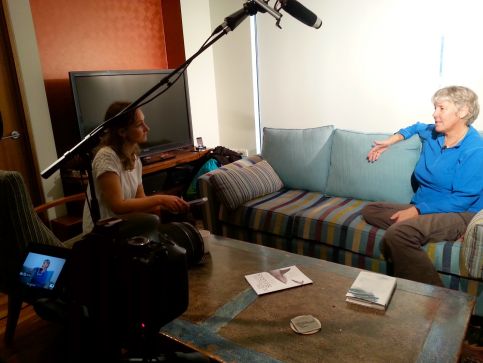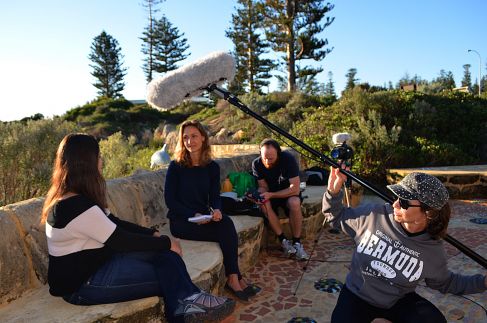A Golden State for Sharks?
Das Shark Savers Germany Team produziert eine Dokumentation über Haikontrollprogramme
Aktuell wird in Westaustralien über das kontroverse “Western Australian shark cull” Haikontrollprogramm debattiert. Es wurde Anfang des Jahres eingeführt um das Risiko von Attacken auf Menschen zu minimieren, indem es Weiße Haie, Tigerhaie und Bullenhaie, die über 3 m lang sind, fängt und tötet. Doch die Effektivität dieses Programms ist von Seiten der Bevölkerung und zahlreichen Wissenschaftlern in Frage gestellt. Weiße Haie sind in den Gewässern Australiens geschützt und das zielgerichtete Töten von fortpflanzungsfähigen Tieren ist nicht nur grausam sondern übt zusätzlichen Druck auf schon bedrohte Arten aus. Die Konsequenz für das Ökosystem und den Ökotourismus könnte verheerend sein. Trotzdem spricht die Regierung von einem Erfolg und will das Programm bis 2017 verlängern. Kaum vorher in der Geschichte gab es einen derartigen Aufschrei in der Bevölkerung und wissenschaftlichen Welt wenn es um Haischutz ging. Doch was sind die Hintergründe? An der Ostküste Australiens werden Haie seit Jahrzehnten vor Badestränden getötet.
Wie sinnvoll sind diese Programme? Welchen Einfluss haben sie auf Haibestände? Wo sonst auf der Welt gibt es Haikontrollprogramme und gibt es weniger destruktive Maßnahmen? Wie können Hai und Mensch zusammen leben ohne einander zu schaden?
Johanna Zimmerhackel, Wissenschaftlicher Vorstand von Shark Savers Germany, ist in Westaustralien und sucht nach Antworten auf all diese Fragen. Auf ihrem Weg trifft sie auf die lokale Bevölkerung, Wissenschaftler, Aktivisten und Politiker. Sie macht mit uns eine virtuelle Reise um die Welt und zeigt uns verschiedene Haikontrollprogramme sowie ihre Ansätze und Auswirkungen.

Johanna im Gespräch mit Professor Jessica Meeuwig. Direktorin des Oceans
Institute der University of Western Australia.
1) Lasst sie eure Stimme hören
Bis zum 07.07.2014, kann man Stellungnahmen an die EPA (Environmental Protection Authority) schicken, die in der Entscheidung der Programmverlängerung einbezogen werden. Wir bitten euch diese Gelegenheit zu nutzen! Schreibt eure Meinung nieder oder nutzt den von uns vorbereiteten Beispielbrief und schickt ihn auf folgender Plattform ab.
https://consultation.epa.wa.gov.au/open-for-submissions/sharkhmp2014-2017/consult_view
Zu Eurer Information findet Ihr hier den Brief auch auf deutsch:
Brief_EPA_deutsch.docx
2) Fördert Aufklärung
Spendet für unser Filmprojekt "A Golden State for Sharks", der Geschehnisse, Hintergründe und sinnvolle Lösungen für Haikontrollprogramme weltweit dokumentiert. Jeder Spender wird im Abspann des Filmes namentlich erwähnt. Die Bankdaten findet Ihr rechts auf dieser Seite - bitte den Betreff:"A Golden State for Sharks" nicht vergessen.
Eine Spendenbescheinigung senden wir auf Wunsch gerne zu.
3) Nehmt an Petitionen teil
http://ccwa.org.au/action/no-shark-cull-wa
http://www.thepetitionsite.com/820/259/345/save-the-great-white-sharks-of-western-australia/

Interview mit Luciana Ferreira. Doktorandin und Tigerhaiexpertin des Ocean Institute,
University of Western Australia.
A Golden State for sharks?
At the moment, people in Western Australia debate about a controversial shark control program, which was implemented earlier this year in order to reduce the risk of shark attacks on popular beaches. The program stipulated for the killing of tiger sharks, great white sharks and bull sharks bigger than 3m. However, the effectiveness of this policy is highly doubted by the Australian people and numerous scientists. Great white sharks for example are protected in Australian waters and the directed killing of mature animals is not only cruel but puts further pressure on species which are already of conservation concern. The consequence for the ecosystem and the local economy could be high. Nevertheless, the government claims the program to be successful and wants to extend it until 2017. For maybe the first time in history, an outcry this size was perceived from people demanding shark protection. But what is the background? On the east coast of Australia, similar programs already kill sharks since decades.
How feasible are these programs? What impact do they have on shark populations? Where else in the world do shark control programs exist and are there less destructive approaches? How can humans and sharks co-exist without harming each other?
Johanna Zimmerhackel, scientific director of Shark Savers Germany is in Western Australia to search for answers to these questions. On her way she meets the local people, scientists, activists, and politicians. She guides us on a journey around the world and presents different shark control programs, their approaches and impacts.
What you can do?
1) Let them hear your voice
Until the 7th of July you can send your statement to the EPA (Environmental Protection Authority). The statements will be taken into consideration during the decision making process whether or not to extend the shark culling policy for another three years. We ask you to take this opportunity and write down your opinion. You also can use the example letter below and submit it on the following platform:
https://consultation.epa.wa.gov.au/open-for-submissions/sharkhmp2014-2017/consult_view
2) Support education
Donate to support the making of our movie "A Golden State for Sharks?" which documents backgrounds and feasible solutions for shark control programs. Each donor will be acknowledged at the end of the movie. You can find all bank details on the right top of this page; when donating, please state the movie title as a topic.
3) Sign petitions
http://ccwa.org.au/action/no-shark-cull-wa
http://www.thepetitionsite.com/820/259/345/save-the-great-white-sharks-of-western-australia/